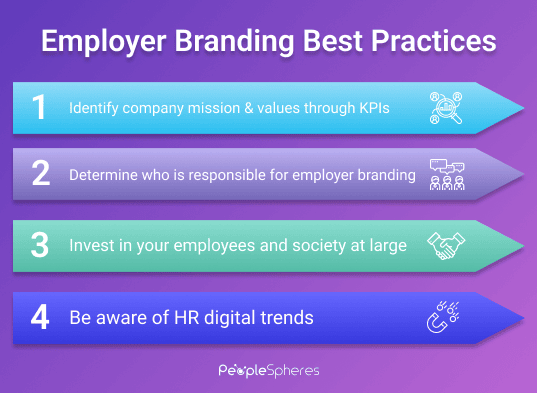
One of the most important ways to stand out as a business is to invest in your employer branding. Employer branding is how you market the employment experience at your company. In today’s workforce, the talent pool is very concerned with company values, ethics, and benefits.
To recruit new hires, employers need to stand out amongst other companies. The experience, reputation, and working conditions of your company are imperative to hire top talents, but also to retaining existing employees for years to come. In order for this to happen, you must find your branding as an employer.
Related articles:
How to Revamp your Employer Value Proposition in 5 Steps
Turn Your Employer Branding into a Competitive Advantage in 8 Steps
What is Employer Branding and Why is it Important?
What is employer branding? Employer branding is the reputation your company communicates to your current employees and potential new hires. The employer branding should be focusing on four essential steps: visitors, candidates, employees, and ambassadors.
Employer Branding as a Competitive Advantage
To attract and retain employees, investing in your employer branding is essential. When you invest in your brand as an employer, you are able to promote a positive work environment which can impact your company’s reputation as a whole. Therefore, it is important that you create an effective employer branding strategy that will give you a competitive advantage in the talent acquisition process and retain top talent. The more you appeal to your employees or job seekers, the better your company will do against other companies.
Employer Value Proposition (EVP)
The employer value proposition (EVP) is a part of the branding strategy and should express the core values of the company, company culture, and benefits that the company offers to employees. Factors that affect a company’s employer value proposition include corporate culture, job security, and work environment. When your HR team is creating your employer value proposition, follow these 5 steps:
1. Identify who is responsible for employer value
2. Identify your EVP target groups
3. Analyze your company’s strengths
4. Evaluate your company’s competitors
5. Draft your employer value proposition
Leadership and Employer Branding
Leaders and top executives of companies are normally the face outward of a business. This means that employer branding is closely related to the leadership of your company. Therefore, it is crucial that your HR leadership train the leaders of their business so their leadership is aligned with the employer brand. HR leadership skills your team should be practicing include communication skills, opposition management, confidentiality, change management, and leading with company values.
Corporate Social Networks
Corporate social networks are becoming a part of employer branding. Corporate social networks provide a clear indication of every individual’s role and skills within the company. It contributes to productive energy and satisfied employees within the company, while it increases cohesion and integration within a context of increased mobility.
Employer Branding Best Practices
In this article, we will address many tips to help you create and identify your company’s employer branding and simplify this task into a much easier one. To develop your employer branding, you must find your company’s mission and values. Then, find ways to communicate your company’s culture through various channels, such as a social media and hiring processes to ensure you find high-quality candidates.
To build your employer branding remember these essential elements; Identify Company Values and KPIs, Determine the Leadership Responsible, Invest in Your Employees and Society at Large, and Stay Up to Date with HR Trends.

Identify Company Mission, Vision, and Values
As seen in many jobseekers, potential employees want to work for a company that makes a difference in society. To display what your company believes in, you will need to identify your company’s mission, vision, and core values.
A company’s mission statement usually includes the purpose of your organization and how they plan to serve the society around them. A company’s vision describes where they see themselves in the future. This will help potential employees envision the opportunities they may encounter in the years to come. A company’s core values are the principles that guide all actions of an organization. At PeopleSpheres, we pride ourselves on our solution and customer orientation, autonomy, and participation core values. To attract new hires, it is important to display what your company stands for, where you see yourself in the future, and how you operate as a team.
Define Objectives and Relevant KPIs
To succeed as a company, you must tailor your objectives and relevant Key Performance Indicators (KPIs) to help meet your goals. Some common KPIs may consist of Time-to-Hire, Number of Applications per Year, and Cost-Per-Hire.
It is very important to keep track of these metrics, so you are able to prioritize your applicant and employee experience at your company. Your objectives and KPIs give an insight into the overall health of the company, employee retention, and the success of HR strategies. When defining and measuring objectives and KPIs, you can assess what is working for your company and what your employees value most to enhance your employer branding and experience.
Determine Who is Responsible for Your Employer Branding
Employer branding is a marketing strategy that is usually assembled by a company’s Human Resources Department. Since employer branding encompasses how current employees feel and what new hires think about the work culture, HR professionals should be responsible.
The HR department oversees the recruitment process, retention of employees, and talent acquisition, so they should help tailor your company’s employer branding to meet the needs of employees by providing a high-quality work environment and work-life balance.
Get Leadership Buy-in
When working on any team, it is not surprising to see that employee engagement increases when leaders value each individual team player. Every organization should strive to have leaders that care and invest in their employees and their performance. But, it is a lot easier said than done. So, how do you get leadership buy-in?
In order to get a “buy-in,” you must communicate how important employee engagement is for the success of your company and the return on investment that it can provide. Engaged employees are more likely to perform better, and less likely to transfer jobs or take absentee days. High performance and retention can save your company thousands of dollars per year and display that you truly care about your employer branding.
Invest in Employee Learning and Development
When you invest in your employees’ education and development, they are going to feel valued. When an employee feels valued, they are more likely to stay loyal to your company since you have given them the resources to feel confident in their work. A survey from 2022 states that:
76% of employees say they’d stay longer at a company if they could benefit from learning and development support.
Microsoft
The investment of employee learning and development has become a must in organizations. To invest in learning and development opportunities, you can offer tuition assistance, on-the-job training, and various workshops to sharpen skills.
Loyal and well-educated employees will increase employee performance and decrease your employee turnover rate. These two results will save your company time and money, as well as promote your mission through employer branding.
Focus on Corporate Social Responsibility
In 2022, employees want to know that their work will make a beneficial difference in society besides growing a corporation. They aspire to see that the corporations they dedicate their time to invest in their community and participate in philanthropic deeds. There has been a major push for corporate social responsibility in recent years, beginning during the pandemic.
When employees dedicate their time and customers spend their money at large corporations, they want to see the money used for more than profit. Many large corporations have been partnering with charities, minimizing their ecological footprints, and promoting volunteer events. When employees have the satisfaction that the work they are doing impacts the society around them, they are more likely to advocate for the company and its values.
Leverage Employee Advocacy
One of the best employer branding strategies you can have is employee advocacy. Employee advocacy is the promotion of your brand through the employees that work there. Word-of-mouth marketing is very powerful and can work for or against you. Your employee may share the benefits of working at your company, typical day-to-day experiences in the office, or new campaigns that are taking place.
Consumers trust online presences and reviews much more than brands, so having employee advocacy is a great way to position your brand for finding potential customers, boosting your reputation, and communicating your employer brand.
Value Employees and Team Building
By showing appreciation and acknowledging the value current employees are bringing to your business, you are more likely to improve your employer brand. Another big concept often overlooked is helping the team manage their task or making sure that they are trained or have the resources to do certain tasks. According to an article:
62% of the people who were struggling to manage their workloads had experienced burnout “often” or “extremely often” in the previous three months
Harvard Business Review
Therefore it is important to know the required skills for a certain task and know if the employee may need help with this.
Another strategy is making sure that everyone on the team is feeling appreciated and valued. You should promote a positive team spirit and make sure that everyone is getting along, as a positive work environment is good for the employer branding as well. By strengthening the links between employees in team-building exercises, you can restore employee confidence.
If you want more tips for successful teamwork, we have an article on team-building ideas.
Use Social Media Channels to Enhance your Brand
Over 3.6 billion people use social media worldwide which is a great way to expand your company’s reach and find the best talent that the internet can offer. Thousands of companies have joined the professional social media site, LinkedIn, to share job ads, connect with potential new hires, and communicate your company’s work environment, benefits, and overall employer branding. Recruiting through social media allows recruiters to reach out to potential employees, but also adds a new way for future candidates to connect with recruiters. Compared to traditional recruitment strategies, recruiting through social media is very inexpensive.
Besides recruitment, how can you use social media to enhance your employer branding? Social media allows you to connect with your audience like never before. Your company can respond to followers, establish its online presence, and market its services or products. In conclusion, using social media consistently can help your brand thrive in many different ways, from recruitment to brand loyalty.
Prioritize Workplace Diversity
As a company, all voices should be valued equally. In order to do so, your company needs to prioritize workplace diversity in many ways. The best way to exhibit an inclusive workplace for all employees of different backgrounds is through acknowledging differences, keeping an open mind, and facilitating healthy discussions about diversity.
To advance your company in workplace diversity, you can offer Implicit Bias Training, and provide diversity and equity resources to your employees. The best way to attract and retain talent is to allow employees to be seen and celebrated for their unique experiences that they bring to the team.
Be Aware of HR Digital Trends
As technology advances day by day, your company’s HR department needs to stay informed about the newest HR Digital Trends. However, it may be difficult to keep up, so it is very important to find reliable resources to provide the latest HR News as we are now in an age of constant technology advances and still struggling with the adaptation of remote work and ways to adapt to newer generations. According to reports,
52% of Gen Z and Millennials are likely to consider changing employers this year, up 3% year-over-year;
Microsoft
For this reason, it is important to have more communication and be on top of the new digital innovations.
PeopleSpheres’ blog provides up-to-date articles on all of the newest HR advancements. Along with blog posts, PeopleSpheres helps assemble the future of employee and HR experiences through a unifying user experience. Integrating tools like the ability to embed LinkedIn feed can amplify this streamlined experience. We offer secure and reliable Human Resource Information Systems (HRIS) for companies in different industries and different sizes.
Staying up-to-date in technology and news for HR can increase the productivity and efficiency of employees in many different areas across your company. Make sure that you are using technology to your advantage and not as a disadvantage. This is important based on research done in 2019 that shows that:
74% of industries saw importance in implementation of HR cloud solutions, but only 41% felt ready to take on this new challenge.
Deloitte Human Capital Trends
Case Study: Building a Strong Employer Brand through HR Innovations
Provalliance, a European leader in the hairdressing market, stands as a compelling case study in building a strong employer brand through HR innovations. Formed from the merger of Frank Provost Group and Regis Corporation in 2008, the company embarked on a significant digital transformation journey. A key aspect of this transformation was the overhaul of their Human Resources functions.
Provalliance aimed to unify their previously disjointed HR activities and modernize them, focusing on eliminating time-consuming tasks like email, fax, and Excel-based processes. This modernization was not just about efficiency; it was integral to their strategy for retaining and attracting talent, including independent hairdressers.
By implementing a modern, agile, and intuitive tool to improve the employee experience, Provalliance enhanced its appeal as an employer. They deployed a unified core platform, ensuring their HR systems were interconnected and adaptable to the specific needs of different business units.
This strategic move not only streamlined HR processes but also positively impacted their employer brand. As a result, Provalliance differentiated itself from other players in the industry, not just through its services but also through its innovative approach to employee management and satisfaction. This transformation has positioned Provalliance as a forward-thinking leader in the beauty industry, demonstrating the significant impact of HR innovation on employer branding
Conclusion
As the workforce changes, employers need to keep up with the demands of talented staff when it comes to work-life balance, working conditions, and encouragement when employees perform well. Strategic recruitment and loyal employees are two of the best ways to save your company time, money, and effort. To accomplish these tasks, an employer brand must be present and followed. Employees strive to feel valued and when a company provides that, they will have a productive and thriving work community. An inclusive and engaged work community can create lasting impacts on your brand’s reputation and employer branding as a whole.
In order to build and display your company’s employer branding, remember to follow the branding best practices:
-
Identify company values and KPIs
-
Determine who is responsible for employer branding
-
Invest in your employees and society at large
-
Stay up-to-date with HR trends




-640x380.jpg)
-640x380.jpg)